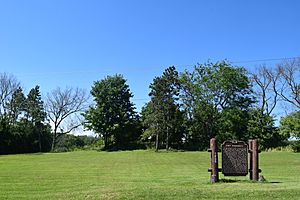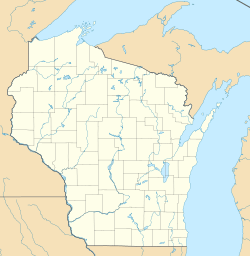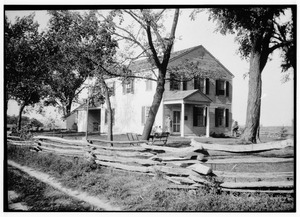Fort Winnebago facts for kids
Fort Winnebago was an important army fort built in the 1800s. It was located in what is now Portage, Wisconsin. The fort sat on a hill, watching over a special path called a "portage." This portage connected two big rivers: the Fox River and the Wisconsin River.
Fort Winnebago was one of three forts built along the Fox-Wisconsin Waterway. The other two were Fort Howard in Green Bay and Fort Crawford in Prairie du Chien. The U.S. Army built Fort Winnebago in 1828. Its main goal was to help keep peace between new settlers and the Native American tribes living there. This was especially important after a conflict called the Winnebago War in 1827.
The fort's location was chosen carefully. It was near where a Native American leader named Red Bird had surrendered. More importantly, the portage was a very busy travel route. It connected the Great Lakes to the Mississippi River. Fort Winnebago helped control who and what traveled between these important waterways.
Soldiers from Fort Winnebago took part in the Black Hawk War in 1832. However, the fort itself was not involved in any other battles. From 1829 to 1831, a young officer named Lt. Jefferson Davis served at the fort. He later became the President of the Confederate States of America. The soldiers also helped build a military road. They also assisted with moving the Ho-Chunk Nation from Wisconsin to Minnesota in the 1840s. By 1845, there was no longer a big threat to peace in the area. So, the army left the fort. Nine years later, the land was sold to private owners. In 1856, a fire destroyed most of the fort buildings.
Contents
History of the Portage
The "Portage" was a narrow strip of land, only about 1.25 miles wide. It separated two major waterways. One river, the Fox River, flowed north towards Green Bay. This path led to the Great Lakes, the St. Lawrence River, and eventually the Atlantic Ocean. The other river, the Wisconsin River, flowed southwest to the Mississippi River. The Mississippi River then empties into the Gulf of Mexico.
This area around Portage was a very old travel route. Native Americans used this path for centuries before Europeans arrived. They knew it was a key connection between the rivers. They walked about 2,700 paces (steps) to cross between them.
In the early 1800s, the U.S. government understood how important this "Portage" was. It became known simply as "Portage." Fort Winnebago was one of three forts built here. These forts aimed to manage relations with Native Americans. They also protected trade along the Fox-Wisconsin water system. This area later became the state of Wisconsin. The other two forts were Fort Howard in Green Bay and Fort Crawford in Prairie du Chien.
The government built Fort Winnebago to protect the fur trade. Native American tribes, especially the Ho-Chunk (also called Winnebago), sometimes charged fees for goods passing through. John Jacob Astor, who led the American Fur Company, asked the government for help. So, the army built a post at the portage.
Fort Winnebago Surgeons Quarters
Quick facts for kids |
|
|
Fort Winnebago Surgeons Quarters
|
|
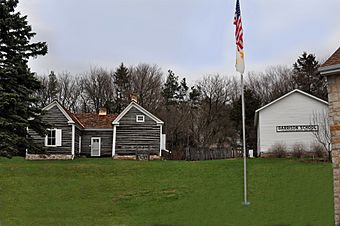
Fort Winnebago Surgeons Quarters Historic Site
|
|
| Nearest city | Portage, Wisconsin |
|---|---|
| Area | 3 acres (1.2 ha) |
| Built | circa 1820-1824 |
| Built by | Francis Le Roi |
| Architectural style | French colonial log home |
| NRHP reference No. | 70000029 |
| Added to NRHP | October 28, 1970 |
Today, only two buildings from the original fort remain. These are the fort's surgeon's and officers' quarters. This building is now called the Fort Winnebago Surgeon's Quarters. It is a historic house museum. The Wisconsin Society Daughters of the American Revolution runs it. It is also listed on the National Register of Historic Places.
The surgeon's quarters was built around 1824 by Francois Le Roi and Therese L'Ecuyer. They were a Métis couple. They ran a fur trading post and a business that helped people carry their boats across the portage. Later, they sold the building to the U.S. Army. It became the home for the fort's doctor. This building is one of the oldest French colonial log homes in Wisconsin. It still stands on its original foundation. It is the only remaining building from the historic Fort Winnebago, which was active from 1828 to 1845.
The Garrison School was built around 1850 near the old fort property. Both the Surgeon's Quarters and the Garrison School are owned and cared for by the Wisconsin Society Daughters of the American Revolution. They operate the Surgeon's Quarters as a museum. It has furniture from the 1800s and artifacts from the fort. The Garrison School is a one-room schoolhouse from the 1800s. It was used until 1960. It was moved from its original spot to its current location next to the surgeon's quarters.
Famous People at Fort Winnebago
Many interesting people lived or worked at Fort Winnebago. Here are a few:
- John Joseph Abercrombie – A Lieutenant
- Jefferson Davis – A Lieutenant from 1829 to 1831
- William S. Harney – A Captain, Colonel, and General
- John H. Kinzie and Juliette Augusta Magill Kinzie – An Indian Sub-Agent and his wife
- Randolph B. Marcy – A Second Lieutenant in the 5th Infantry from 1832 to 1835
- Edwin Vose Sumner
- David E. Twiggs – A Major
- Charlotte Ouisconsin Clark Van Cleve
- Horatio P. Van Cleve – A Second Lieutenant in the 5th Infantry from 1831 to 1836
Historic Indian Agency House
|
Historic Indian Agency House
|
|
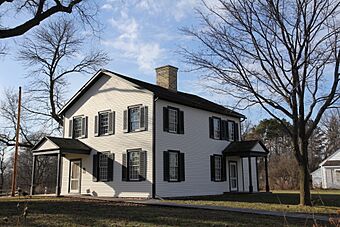
Historic Indian Agency House in December 2014
|
|
| Location | NE end of old Agency House Rd. (Rte.1) near NE city limits, Portage, Wisconsin |
|---|---|
| Area | 1.4 acres (0.57 ha) |
| Built | 1832 |
| Architectural style | Federal, New England Colonial |
| NRHP reference No. | 72000045 |
| Added to NRHP | February 1, 1972 |
The Fort Winnebago Old Indian Agency House is another original building connected to the fort. It is the only known Indian Agency building still standing in its first location. The U.S. Government built it in 1832. It served as a home and office for John H. Kinzie. He was an Indian sub-Agent. His job was to be a link between the local Ho-Chunk (also called Winnebago) Nation and the U.S. Government.
John Kinzie lived there with his wife, Juliette Augusta Magill Kinzie. Juliette later wrote a book about their experiences. It was called 'Wau-Bun, the "Early Day" in the Northwest'. Since 1932, The National Society of the Colonial Dames of America in Wisconsin has operated the house as a museum. It displays items about Native American culture. You can visit it from May 15 through October 15 each year. It was added to the National Register of Historic Places in 1972.


